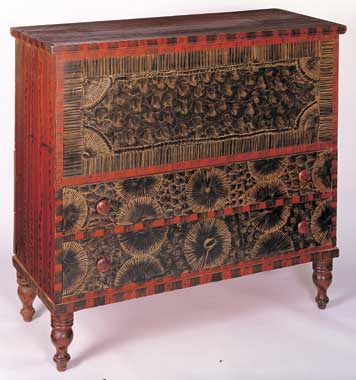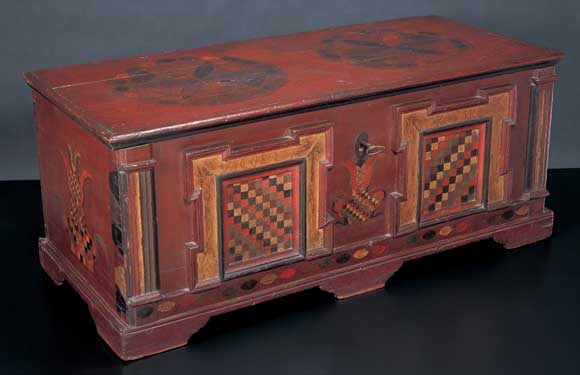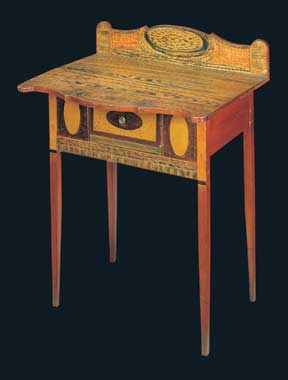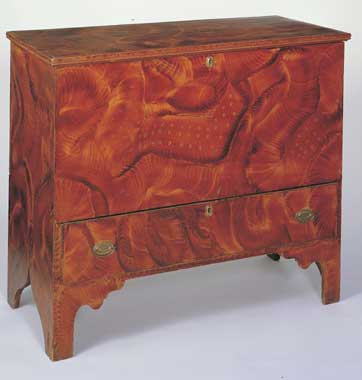Chest Over Drawers
Artist unidentified




For most of us, the sheer tactile pleasure of running one’s fingers through wet, viscous paint is primarily experienced in young childhood. During the early decades of the nineteenth century the abstract whirls, swirls, and dots that we reveled in as children were elevated to a highly expressionistic and controlled manipulation of wet paint on wood surfaces. Using their fingers, brushes, and a variety of textured materials to direct the process, professional decorative painters produced fantastic, creative effects that glorified even the humblest piece of furniture. This transforming power of paint is considered in the exhibition “Surface Attraction.” The museum’s collection is particularly rich in these bold expressions on furniture that transcends utility through the masterful application of colorful paints and pigmented glazes in visually dynamic patterns. Various techniques were employed to achieve stunning—and sometimes startling—effects, using an array of tools to maneuver the paint.
Multiple factors had an impact on painted decoration applied to furniture. Aesthetic concepts remembered from Europe migrated with the earliest colonists. Other fashionable ideas were conceived in Europe, quickly proliferated in America’s urban centers, and soon after reached localized areas of furniture making, where they were interpreted and adapted to new markets. Changing methods of production and distribution, technical innovations, and such mundane considerations as cost, skill level, and quality of pigments also had a significant effect on the appearance of painted furniture.
Throughout the eighteenth and nineteenth centuries, the same professional once practiced many genres of painting. As these applications separated into artistic and “mechanical” spheres, painters increasingly specialized in one area or another. The canvas upon which the artists in this exhibition worked was furniture, and their efforts enlivened homes throughout the American countryside. Today their names are largely lost to history, but their fingerprints remain in the expressive “paintings” they have left behind.

Armchair With View of Ithaca Falls
Chairmaker unidentified
Ithaca, New York
c. 1817–1825
Paint, bronze powder stenciling, and gold leaf on wood, with rush seat
37 3/4 x 21 x 16 1/2 in.
American Folk Art Museum, gift of Ralph Esmerian, 2005.8.19

Dower Chest
Johannes Kniskern (1746–?)
Schoharie County, New York
1778
Paint on pine with iron hasp, key, and hardware
19 3/4 x 47 x 21 in.
American Folk Art Museum, gift of Ralph Esmerian, 2013.1.31
Photo © 2000 John Bigelow Taylor, New York

Federal Sideboard Table
Artist unidentified
New England
1810–1830
Paint on wood with brass knob
34 7/8 x 26 x 20 in.
American Folk Art Museum, Eva and Morris Feld Folk Art Acquisition Fund, 1981.12.6
Photo by John Parnell

Chest Over Drawers
Artist unidentified
New England
1825–1840
Paint on wood, including basswood
40 x 42 1/4 x 18 1/4 in.
American Folk Art Museum, gift of Jean Lipman in honor of Cyril I. Nelson, 1994.5.1
Photo by Gavin Ashworth

Chest Over Drawers
Artist unidentified
New England
1825–1840
Paint on wood
35 x 40 1/4 x 19 in.
American Folk Art Museum, gift of Jean Lipman, 1995.4.7
Photo by Gavin Ashworth

Side Chairs
Possibly Worcester Chair Factory
Worcester, Massachusetts
1820–1835
Paint on maple and pine
33 1/4 x 15 3/4 x 18 in.; 33 1/2 x 17 x 18 in.
Private collection
Photo © 2000 John Bigelow Taylor, New York
“Surface Attraction: Painted Furniture from the Collection” is supported in part by the Gerard C. Wertkin Exhibiiton Fund.